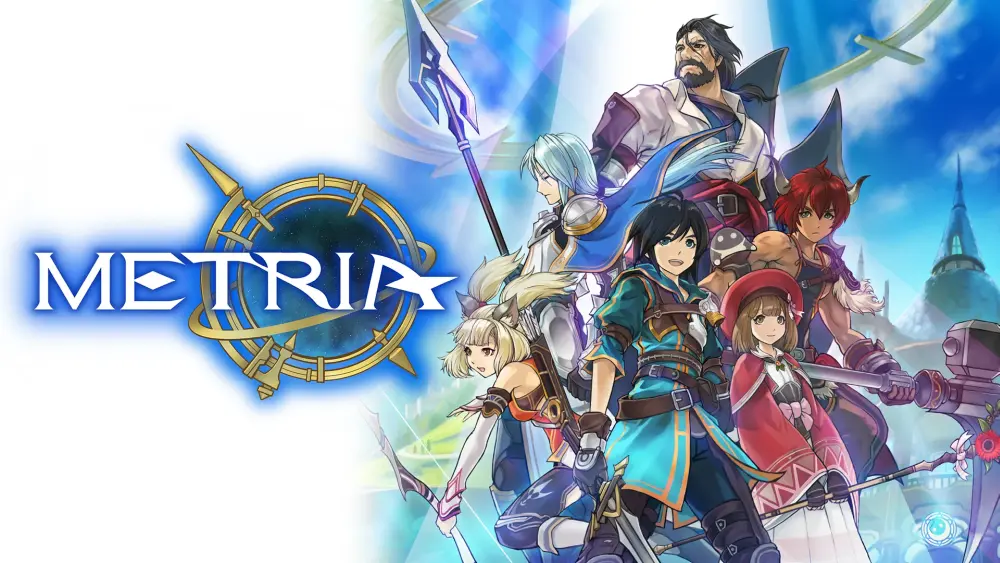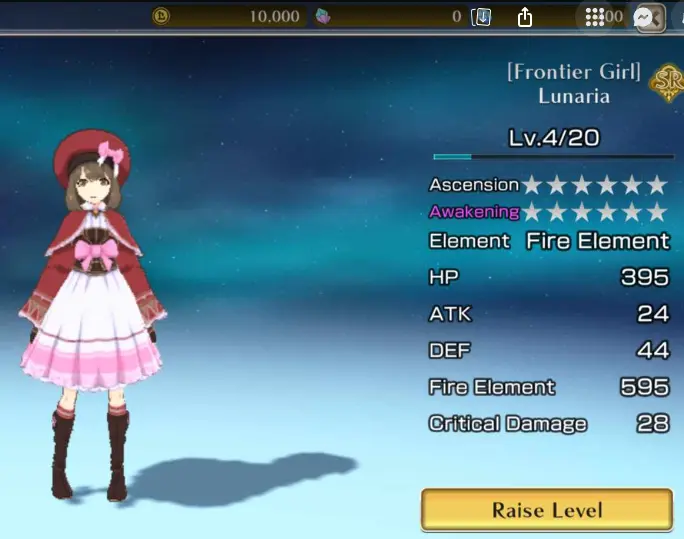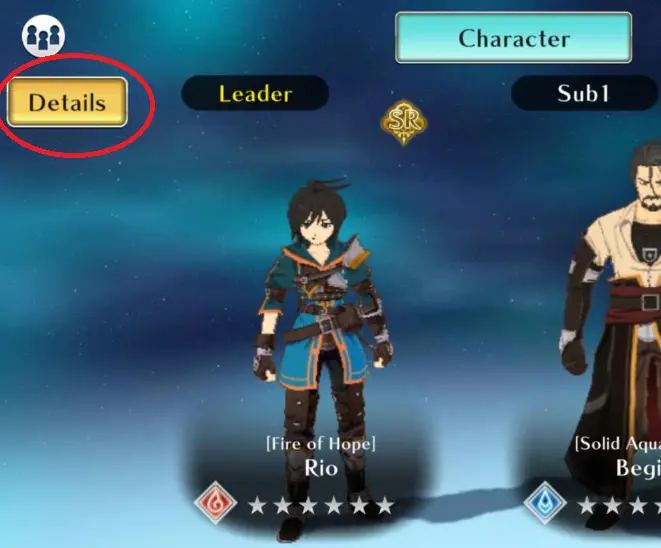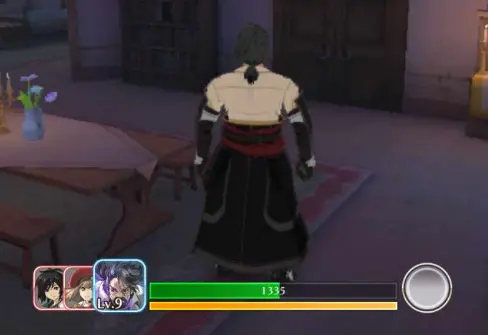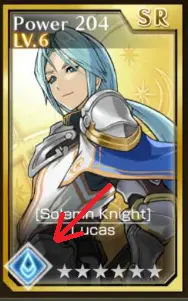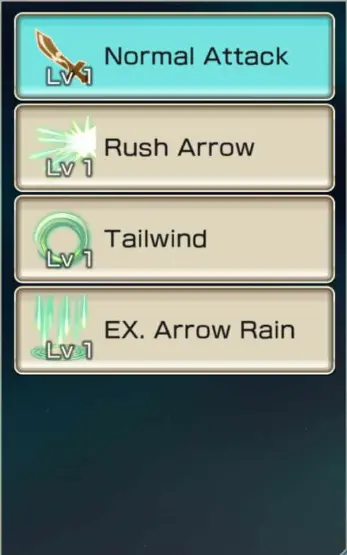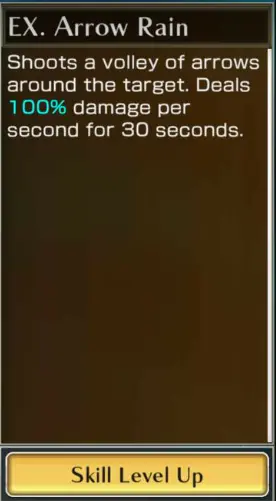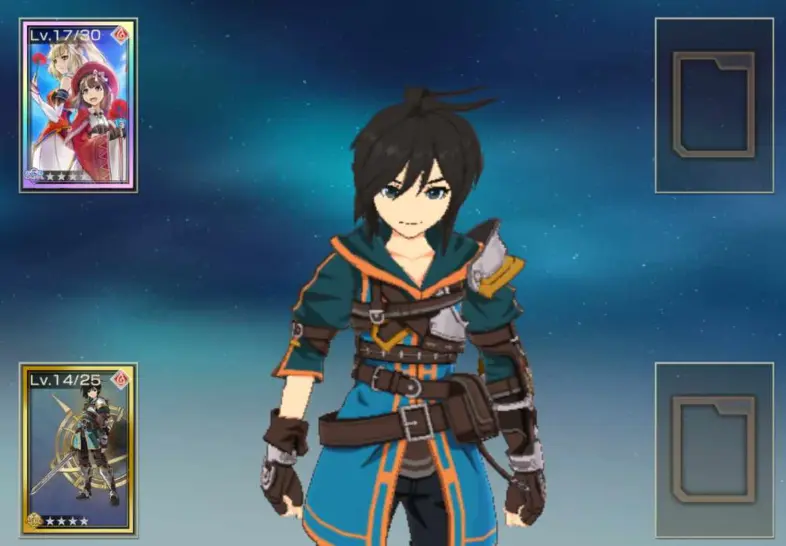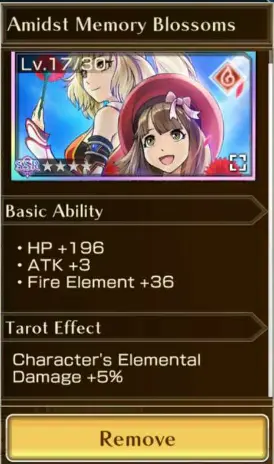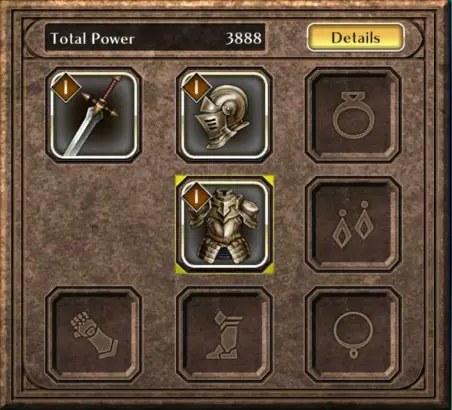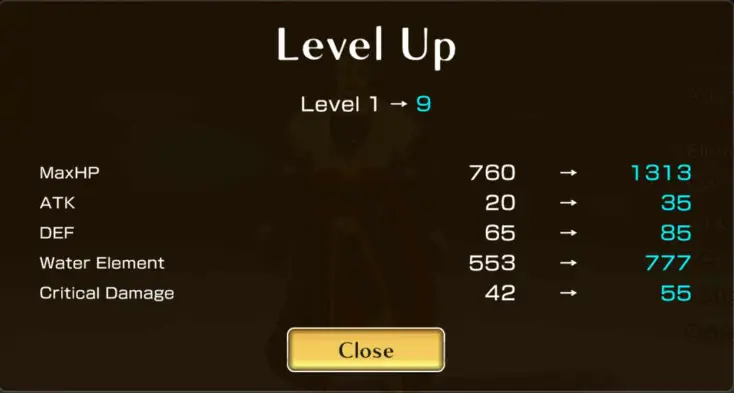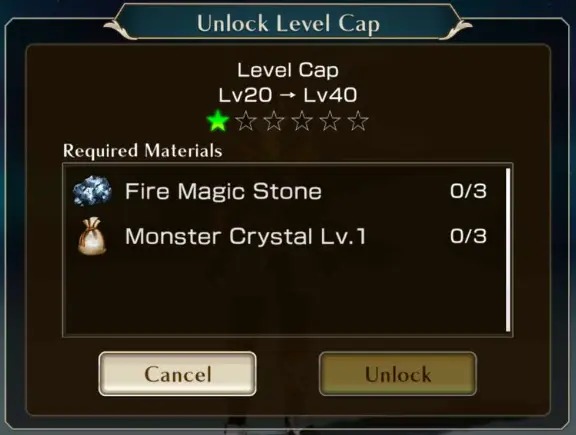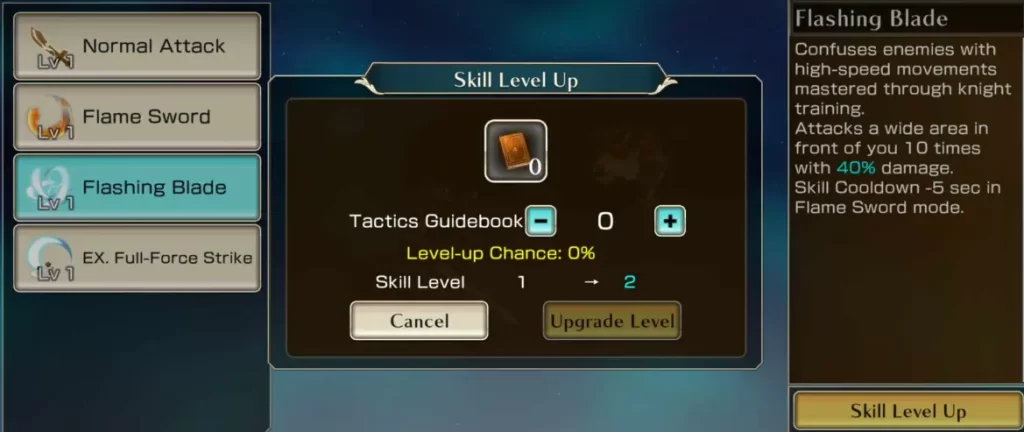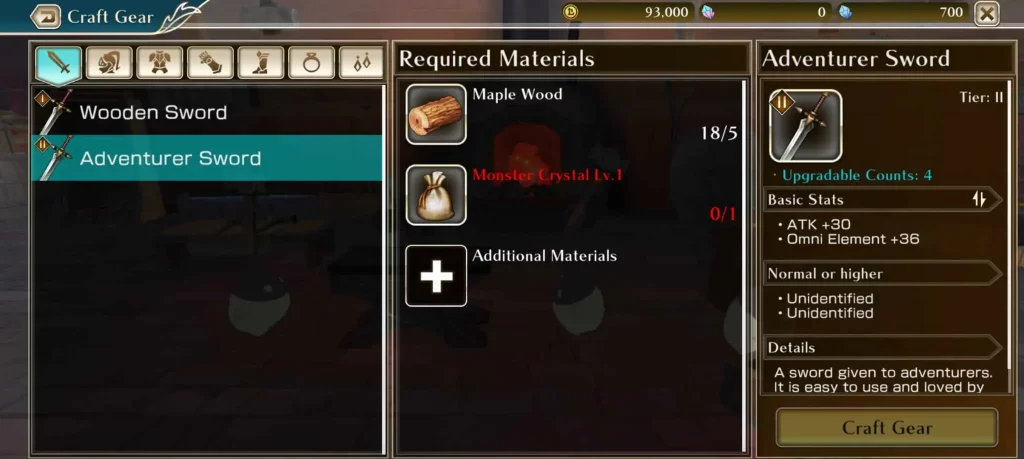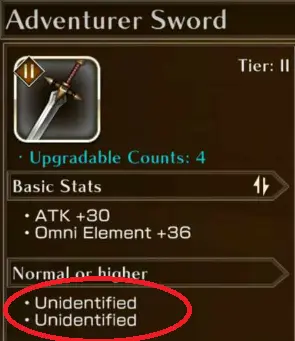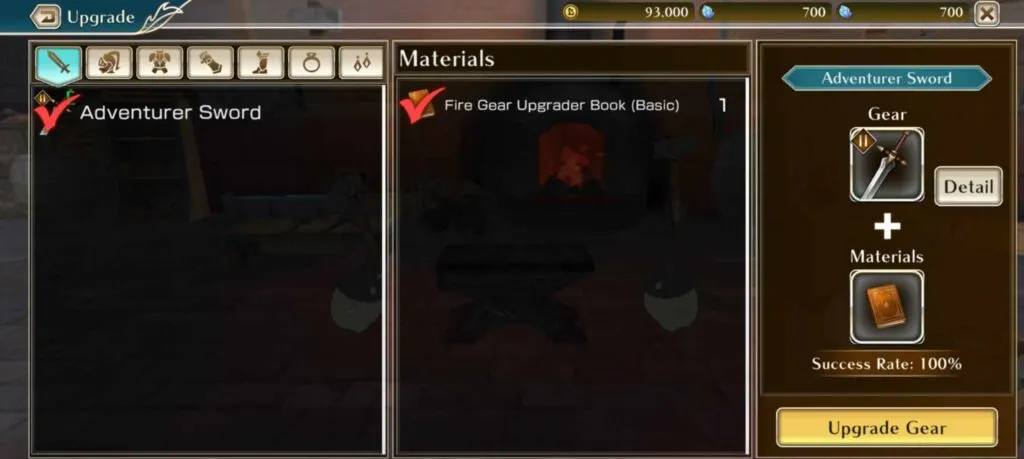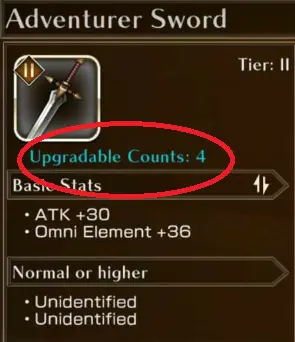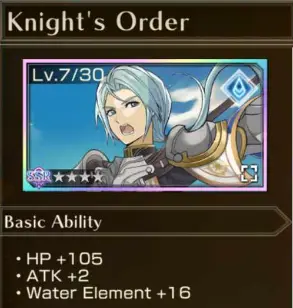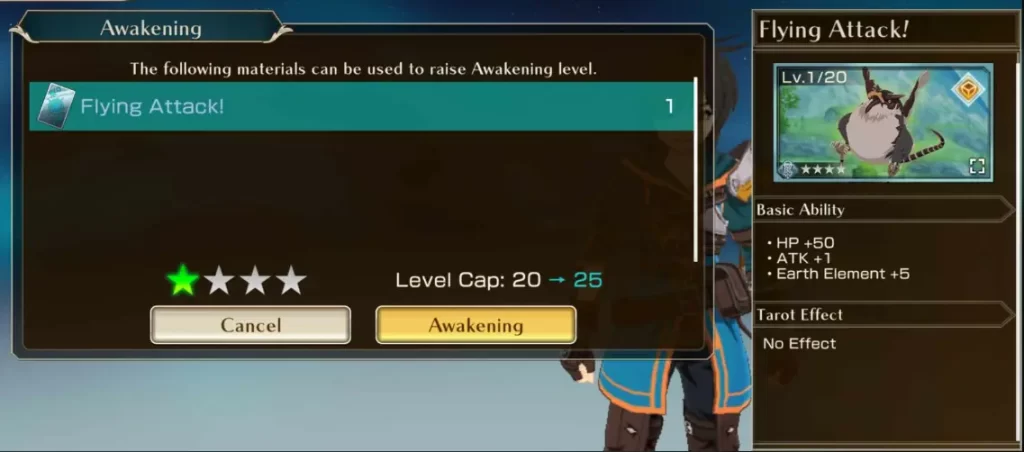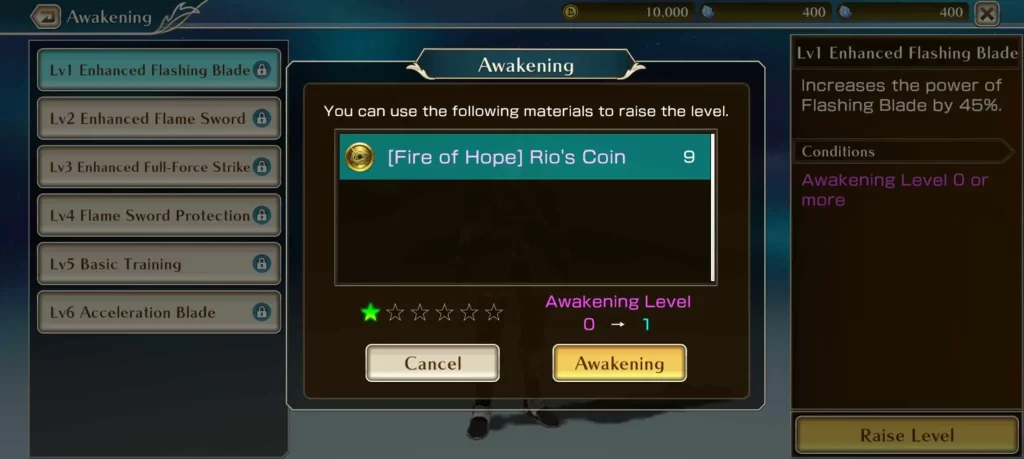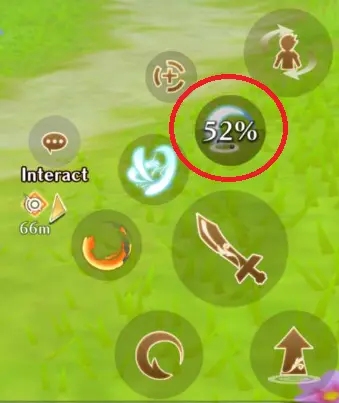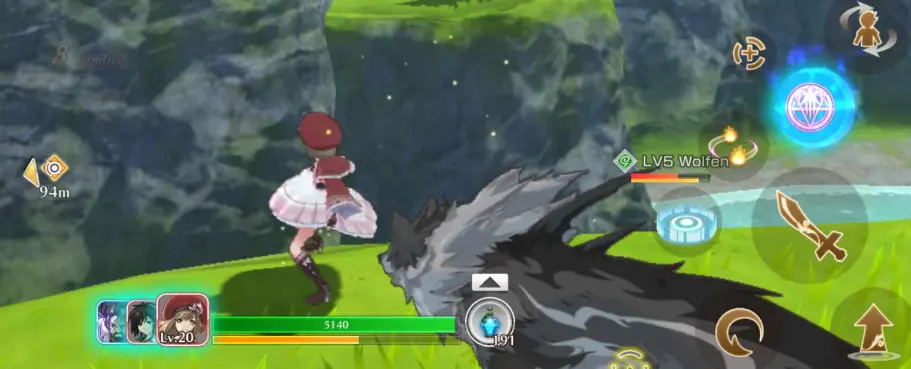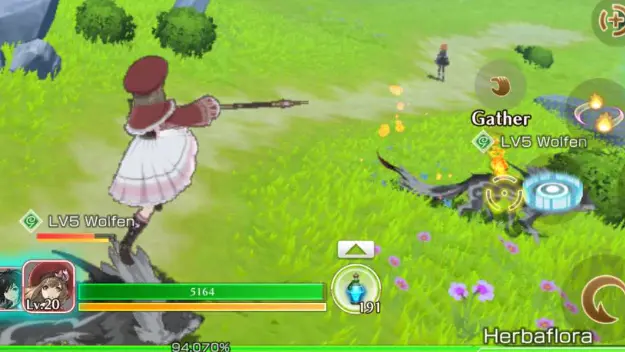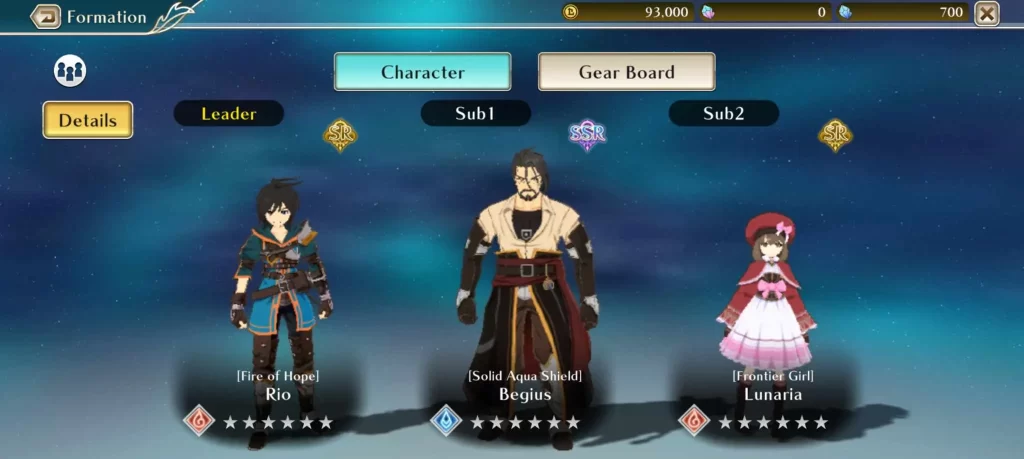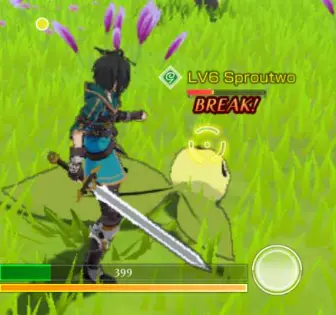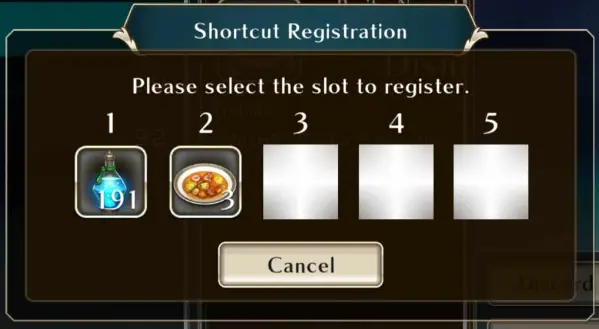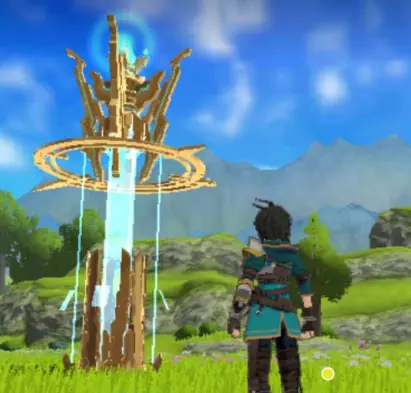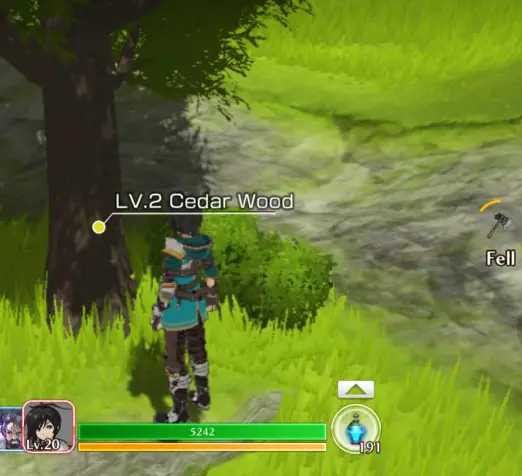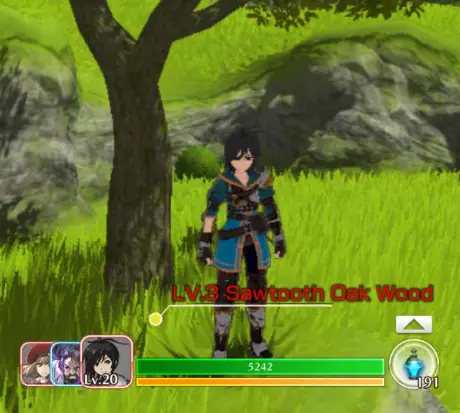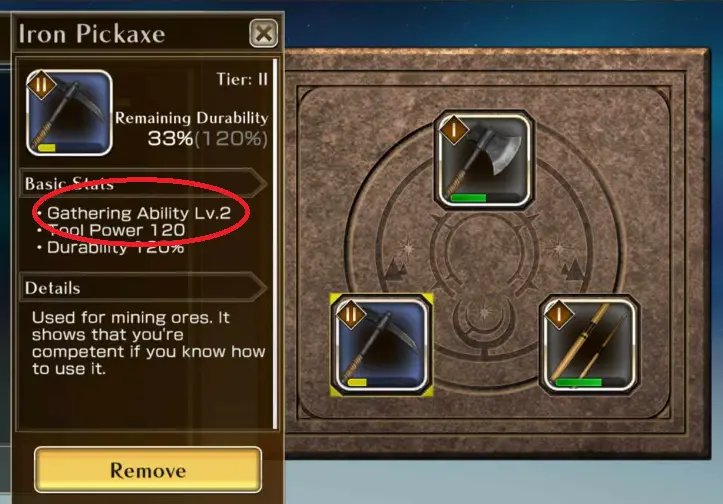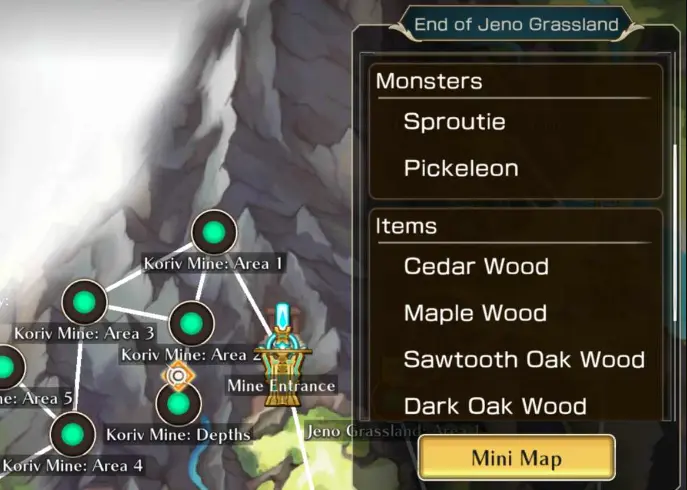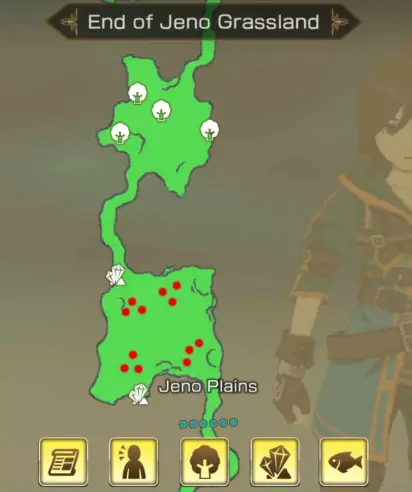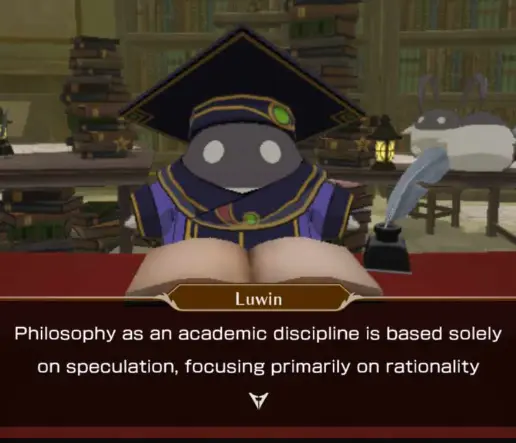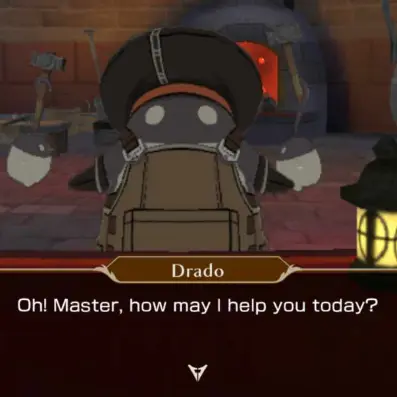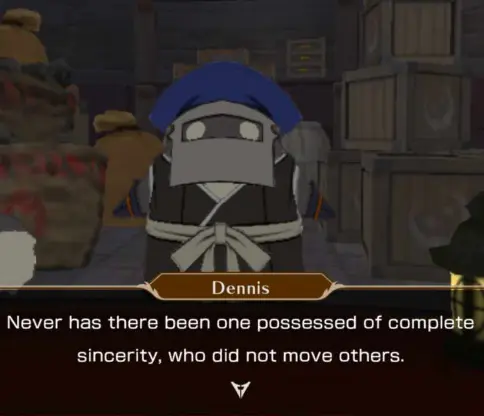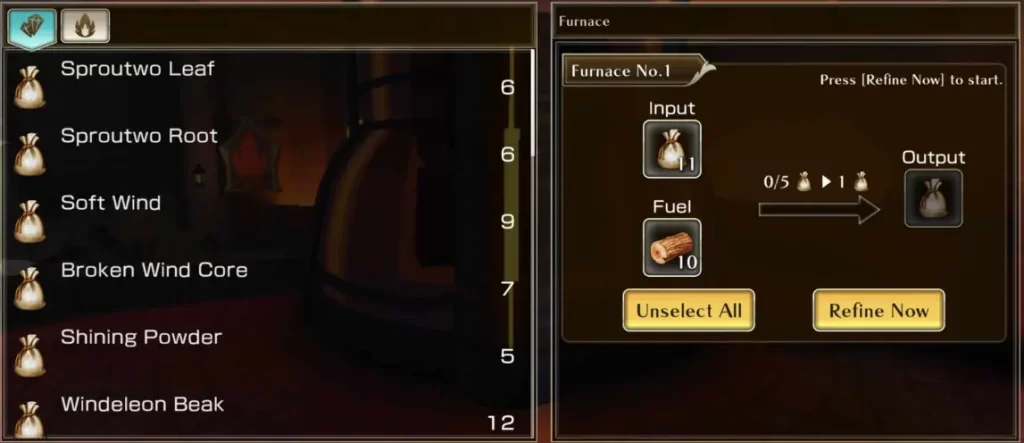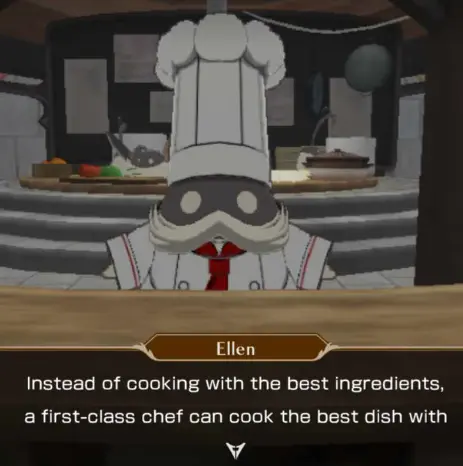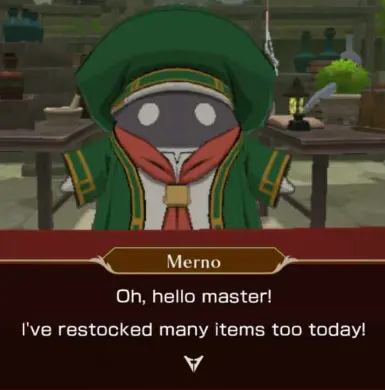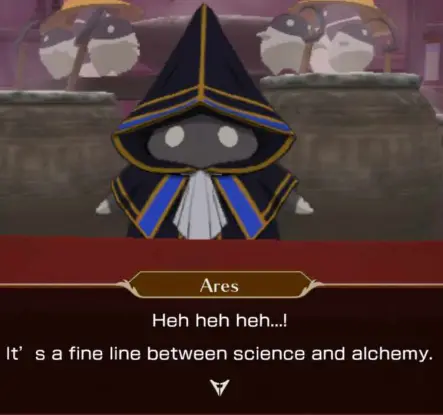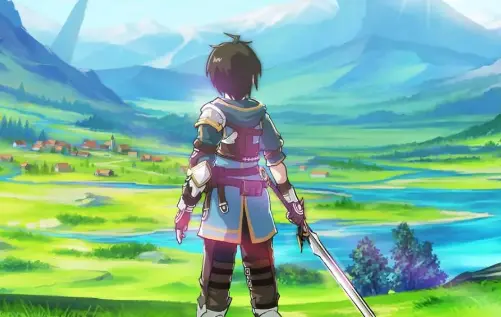Eons ago, the 9 Deadly Sins were born out of the darkness and were poised to conquer the world. But just when it seemed that all hope was lost, 12 legendary warriors – the Astra Knights – rose up and drove back the Sins, restoring peace to the land. To this day, the Astra Knights are revered for their heroism, and the modern incarnations of these mythical figures strive to emulate the great deeds of their predecessors by doing whatever it takes to ensure the world is safe.
Unfortunately, it seems they’ve failed.
Metria is a mobile JRPG from Asobimo, that opts for an open-world, MMO-like feel. In Metria, you step into the sabatons of Apprentice Knight Rio Calquinos, a conveniently amnesiac knight who fought to save Princess Loara from her would-be attackers, only to be whisked away by magic at a pivotal moment. Along with your senior Astra Knight Lucas, you’ll need to assemble a new cadre of powerful and reliable allies as you march back to carry out your knightly duties and unearth the truth of King Regulus’s death.
Metria is a very conventional JRPG, and its story plays out like an early 2000s RPG. Tropes aren’t bad, however, and there’s plenty of fun to be had in Metria, whether that’s via collecting characters, building ideal team rotations, building and refining equipment, or just exploring the world. Gameplaywise, it’s very similar to mobile RPGs such as Genshin Impact or Tower of Fantasy, and players of those games (or any open-world RPG, for that matter) or Asobimo’s previous games Iruna or Toram Online should have no trouble at all getting accustomed to Metria.
If, however, you’re looking for a preview of what lies ahead or if this is your first mobile JRPG and want to get a leg up on the basic systems, this guide is for you!
In this beginner’s guide to Metria, we’ll be going over:
- Characters. Every RPG requires at least a surface-level understanding of its characters and how they work so that you can read them yourself and make your own decisions.
- The numerous ways of strengthening your heroes. Levels, Tarots, gear, skill levels, awakening, ascension, and so on – and where to get the materials you’ll need to undertake these processes.
- Combat. While full of wonder and beauty, the world is also dangerous. Let’s take your sword arm for a few swings to ensure that you know how to defend yourself.
- Exploration basics. The world of Metria is vast and wide, and learning to navigate it efficiently is important for a smooth and pleasant gameplay experience.
- Base management. Progressing through the game gives you a hub, and using the services in Alagoon is key to Metria’s gameplay.
Knightly Basics
As with every RPG, understanding your characters is a good place to begin. Here we’ll examine our characters in detail so that you’ll be able to better understand them – later on, you can use this knowledge to find key points to improve them.
Quick Tips:
- Metria uses a simple stat system.
- Parties in Metria are composed of 3 characters. Note that the party shares HP – switching out to an “uninjured” character won’t refill your HP bar!
- Heroes have a rarity. In general, the higher a character’s rarity, the better its stats and skills.
- Each character in Metria belongs to one of six elements. Elements are important as they not only allow you to deal more damage but also guard break enemies of the element that your active hero is strong against.
- The elemental system in Metria is as follows: Fire > Wind > Earth > Water > Fire, and Light < – > Dark.
- Each character has access to a normal attack, 2 skills, and an ultimate. Careful analysis of these will allow you to determine how to use a character.
- Characters can equip up to 4 Tarots. These are special “equipment” that provide stats and element-related bonuses.
- Characters have access to a gear board. Equipment here is shared across all your active characters.
Hero Stats
Let’s start with the most basic facet of characters – their stats.
To bring up a character’s stats, tap on them in the “Edit Character” screen. This will give you a basic rundown of their stats:
- HP – how much HP this character contributes to the team. More on that in a little bit.
- ATK – attack power. Used for most, if not all skill calculation.
- DEF – defense power. How much damage reduction this hero has when they’re the active character.
- X Element – this one’s tricky as there are no in-game references to it. From what I’ve gathered, it’s just extra attack power IF it matches your character’s element. For example, Rio, who is a Fire character, will get a little bonus damage out of boosting his Fire Element stat but won’t get any bonus from other elemental boosts. It also seems to have some effect on weakness damage.
- Critical Damage – how much bonus damage this character’s critical hits do.
However, that’s not ALL the stats. To get an even more in-depth view, head to “Formation” and then tap “Details”.
This will bring up information like:
- Critical Chance – the chance of this character to land a critical hit.
- Elemental Damage Bonus – how much extra damage this character does with their elemental hits.
- Ignore DEF Chance – the chance that an attack will bypass the enemy’s DEF during damage calculation.
As a new player, I wouldn’t worry about these extra stats so much. Focus on building up your core stats of ATK, DEF, the respective element, and some crit chance and damage while you’re at it.
About HP
The HP system in Metria is unique. While each character does have an individual HP score, they do not possess individual health bars. Instead, your team of 3 characters shares a single HP bar whose value is the sum of your trio’s HP stats.
Note that while HP is shared, DEF is only factored for the character on the field – not the sum of the team’s DEF!
Hero Rarity
All heroes have a rarity. The higher the character’s rarity, the shinier its card is.
In general, a higher rarity means better performance.
Elements
Characters in Metria are defined by the elements. There are six elements in the game: Fire, Wind, Earth, Water, Light, and Dark.
Elements aren’t just for show. Each element is strong against another, and attacking a foe with an element it’s weak against causes you to deal bonus damage.
The elemental cycle in Metria is as follows:
- Fire beats Wind.
- Wind beats Earth.
- Earth beats Water.
- Water beats Fire.
- Light and Dark beat each other.
Note that there are no penalties for attacking counterclockwise in this system, though you will definitely want to avoid taking weakness damage!
Hero Skills
Each hero has access to 4 skills. These are their normal attack, 1st skill, 2nd skill, and EX skill.
Normal attacks are what you get when you tap the attack button. More often than not, a character’s normal attack is a series of multi-hits. Note that each attack tends to have a different damage multiplier.
A character’s 1st and 2nd skills are both active skills. These can range wildly; some straight-up deal damage, some toggle modes, while still others grant buffs and debuffs. 1st and 2nd skills operate via cooldown.
As a character fights, they build up energy that can be used to activate their EX Skill, which is essentially an ultimate. These are very powerful, and it’s a good idea to read up on what they do so that you can maximize their use. Note that EX Skill energy doesn’t fade with time, so you can save it up and unleash the skill at a crucial moment.
In the skill screen, you can get a more detailed reading of exactly what a skill’s effect is, including its damage, multipliers, and any debuffs it inflicts.
Tarots
Each character also has 4 Tarot slots. Tarots are essentially extra equipment (read: stat sticks) that only activate on the character they’re equipped to.
Each Tarot not only gives stats (in general, they give a bit of HP, ATK, and a fair amount of a certain element) but also has a unique ability, which can be seen at the bottom of the Tarot in question:
I would argue that these abilities are the whole point of using a Tarot, so try to match them to characters that can fully utilize these passives!
Finally, note that you cannot have duplicates of a Tarot. Duplicates are used to awaken Tarots, which will talk about in the “Strengthening the Team” section.
Gear
Aside from Tarots, you also have normal equipment. You can’t escape the grind!
Like the party HP system, Metria has a unique take on gear. Items aren’t equipped to each character, but rather to a Gear Board via the formation screen. If you think this means that the active shares this equipment, you’re correct. This system makes it easier to outfit teams with generalist gear at the cost of making specialist gear builds tougher.
If you’re worried about X Elements in gear, fret not: most, if not all pieces of equipment come with Omni Element, meaning they contribute to a character’s elemental strength regardless of their element.
Strengthening the Team
Now that you know how to read your characters, let’s talk about strengthening them. As I’m fond of saying, strategy is important, but so is raw strength. This section will help you make your heroes the best they can be.
Quick Tips:
- Leveling up is the fastest way of strengthening your heroes. You can either kill monsters on the field or use experience diaries to do so. I recommend just beating up monsters as diaries can also be used to level up Tarots.
- Take note that character level is different from account level. The number at the bottom left of the screen is your account level. You can raise your account level by beating up monsters and completing quests.
- Every so often, you’ll need to Unlock a character to push their level limit higher. Materials for this come from daily dungeons and can also be mined. Monster Crystals must be refined via your Furnace.
- You can boost a character’s skill levels, which in turn will push the numbers of that skill higher. However, skill level materials tend to be quite rare in Metria so I suggest finding a team you like before committing to skill level boosts.
- Once you have access to the base, you can start forging equipment. The higher your Blacksmith’s level, the more recipes you’ll have available.
- Gear can be upgraded by using special materials, most (if not all) of which are made at the Alchemy station.
- As a beginner, don’t focus on min-maxing your gear – that’s more mid-to-endgame stuff. Instead, try to fill each slot with the best gear you can at your current level.
- Each character can equip 4 Tarots. Tarots essentially serve as stat sticks. Tarots, like characters, can be leveled up.
- Tarots have both an element and an ability. To get the most mileage out of your Tarots, you should try to equip characters with Tarots that boost their element and provide special bonuses for that element.
- Character duplicates are converted to coins. These coins can be used to Awaken characters. Each character has 6 Awakening levels, each of which provides them with a unique and powerful bonus.
Leveling Up
The fastest way to strengthen your characters is by leveling them up. There are two ways to go about this: either beat up monsters or feed characters experience items. I would recommend just fighting monsters – there are tons of them after all, and the only way to level Tarots (at least as far as I’ve found) is by feeding them the same experience items as characters, so it’s prudent to set those materials aside.
Every time you kill a monster, you get a bit of experience. The higher your level, the more experience you’ll need. Note that every character in your active team gains experience, not just the one you’ve switched to. Thus, you can babysit lower-level characters by keeping them in a slot and never switching to them.
However, note that character experience is different from account level. Beating up monsters and completing quests nets you both; it may even be more practical to think that your characters gain experience whenever your account does. Your account level is the number at the bottom left of the screen, and its experience bar is the one at the bottom:
You mostly get experience tomes from doing quests.
Unlocking
Of course, characters can’t level up forever. Every so often, you’ll hit a level cap. Breaking this level cap requires special materials and will allow you to continue leveling up that character.
Unlock materials can be found by doing the Dungeon of the Day in the Chamber of Trials. Each dungeon drops materials for its element, and each of them is only open on specific days.
- Dungeon of Fire: Tuesday, Saturday.
- Dungeon of Water: Monday, Wednesday.
- Dungeon of Wind: Tuesday, Thursday.
- Dungeon of Earth: Thursday, Saturday.
- Dungeon of Darkness: Monday, Friday.
- Dungeon of Light: Wednesday, Friday.
- On Sundays, you can challenge any elemental dungeon.
These dungeons consume AP, a special resource that works like stamina. AP regenerates over time. Alternately, you can mine for said crystals – just watch out for big, shiny crystal formations during your travels.
Level 1 Monster Crystals, on the other hand, are acquired by refining monster gibs at your furnace back in your base. Five of any kind of drop from a level 1-15 monster (it must be the same item though) and some fuel (wood will do) yields a single Monster Crystal Lv. 1. The good news is that since the level of the crystal is determined by the level of the monster drop, there’s nothing stopping you from going to the Jeno Grasslands again and beating up Pickeleons until you have enough gibs.
Skill Levels
Another easy (if sporadic) way of increasing your characters’ power level is by leveling up their skills. Doing this is simple – just go to their page, tap the skill you want to level up, and bam, new level. The higher a skill’s level, the better its numbers.
However, as the game itself notes, skill leveling materials are rare and usually only come from events. Be very, very prudent about whose skills you want to level up as each skill book spent is not easily regained!
Gear
As you progress through the story, you’ll eventually unlock your base, and with it, the ability to craft items. And most of the items you’ll be crafting will be more equipment.
To forge gear, you’ll need to build the blacksmith. At the Blacksmith, you can use materials you’ve harvested from the world (lumber, ore, monster bits, and processed materials from the Furnace) to create a piece of equipment. The higher your Blacksmith’s level, the more recipes it will have for you.
When a piece of equipment is created, it’s rolled with random stats apart from what’s listed, as seen here:
These stats are only revealed once the item has been created. Remember when I said this would be your newest obsession? I wasn’t kidding.
But wait, there’s more!
Gear can also be upgraded, though this comes in a bit later. Essentially, you’ll need special materials – most of which are crafted via the Alchemy station – to upgrade your gear. Said upgrade materials also require you to dismantle gear via the Furnace to obtain Gear Shards. Once you have all the items needed, simply head to the Blacksmith and choose to upgrade gear, select the item you want to upgrade and the upgrade material you want to work with (don’t forget to tap the items and press “Select” on the upgrade screen), and bam – stronger item.
It’s worth noting that upgrades can be risky; initial upgrade materials are safe, with a 100% success rate, but upgrade materials with a higher payoff will also have a failure rate. Pair that with the fact that each piece of gear can only be upgraded a certain number of times…
…and you have a recipe for madness. As a new player, don’t worry about getting 100% perfect rolls just yet – your efforts are best conserved for later in the game. For now, just focus on getting some decent gear on your board and upgrade when you can.
We’ll discuss the production cycle in greater detail in the “Base Management” section.
Tarots
While you can level up your characters, be sure not to ignore your Tarots.
Remember – each character can equip 4 Tarots that essentially serve as stat sticks. Tarots can be leveled up just like characters in that you can feed them experience items to boost their level and the stats they impart. However, unlike characters who can gain experience from beating up monsters, Tarots cannot. Thus, I’d advise you to save your experience items for your Tarots.
Tarots generally align with one of Metria’s six elements. As each Tarot level slightly boosts HP, ATK, and its respective elemental power, it’s highly advisable to match Tarots with characters of their element.
Note that Tarots have a maximum level depending on their rarity. SSR Tarots can go up to level 30 by default, SR Tarots can go up to 25, while Rares can only go up to 20. You can break these limits by awakening a Tarot – which means sacrificing a duplicate of that Tarot. This process not only increases the Tarot’s level cap and bonus stats but also enhances its passive effect. You’ll need to tap which Tarot to sacrifice while in the awakening screen, and the button only becomes available if you have duplicates to burn.
Tarots pretty much only come from gacha.
And speaking of awakening…
Awakening Characters
Naturally, Metria has a system to incentivize pulling for duplicates of characters via its awakening system.
Each time you pull a copy of a character you already own, you’ll gain a coin of that hero. These coins can be spent in that character’s screen to grant them unique, powerful bonuses, not unlike many gacha games. Characters can undergo 6 awakenings.
If you’ve already fully awakened a character and still have some coins left over, you can simply dismantle the extra coins from your inventory. This will convert them into Star Shards that can be exchanged for stuff in the Exchange Center (via the in-game shop menu).
Combat 101
Now that your characters are leveled and geared, it’s time to tackle the world. While you’ve undoubtedly got some combat experience under your belt, here are some extra tips to help you really shine in battle.
Quick Tips:
- Pay close attention to your EX Skill’s charge level. These are very powerful and can turn the tide of battle by themselves.
- Never neglect your defensive options. Dodge rolls help you get out of the way of dangerous attacks, while jumps are a versatile tool that can be used to avoid foes and even chip in damage with midair attacks.
- Each character has a role that you can infer from their kit. Use this knowledge to build an effective team of 3 and remember that not everyone has to be a main DPS – some characters are perfectly fine with being rotated in, popping a skill, then rotating out.
- Note that team switching is one way; Main -> Sub 1 -> Sub 2 -> Main.
- Below each monster’s health bar is a yellow “toughness” meter. This can depleted with repeated attacks (weakness damage seems to drain it faster) and once it hits zero, the monster enters a Guard Break state where it will be stunned and you can freely keep up your attacks.
- Weakness damage hits hard. Always leverage weakness damage when you can as the bonus damage stacks up very quickly.
- Don’t forget to register your most-used consumables, whether they be potions or food buffs!
Keep An Eye on Your EX Skill
Thanks to Metria’s real-time combat, it’s easy to lose yourself in button-mashing action. While that’s well and good, one thing I should remind you of is your EX Skill bar.
EX Skills are tremendously powerful abilities that are more than capable of turning the tides on their own. Because of this, it’s wise to keep an eye on the level of your EX Skill and reserve its use until absolutely necessary!
Movement Options
Don’t forget that you can both dodge roll and jumpin Metria. It’s all too easy to forget these options exist when you want to push out as much damage as you can. Remember – if you’re dead, your DPS is 0!
Dodge rolls can be done to quickly get out of the way of an attack. Monster attacks in Metria can only be gauged by watching the monster’s animations, and in general, I find that it’s much easier and more efficient to simply not be where the monster is attacking. Note that dodge rolls cost stamina (the yellow bar under your team health bar), though they’re the only mechanic to do so. At full stamina, you can dodge four times.
Jumping, on the other hand, allows you to take the fight to the air. There are a surprising amount of airborne enemies or enemies with airborne attacks, and by engaging them in mid-air, you can keep pouring the damage on. Each character also has an airborne normal attack which usually gives you an extra bit of airtime if you want to avoid the ground.
Defensively, jumps can also be used to avoid attacks. Metria does follow a hitbox system, so unless an enemy’s attack has enough of a vertical hitbox, you should be safe in the air – you can follow this up with an air attack against attacks with long active hitboxes. You can also use jumping to get around enemies when multiple monsters are attacking you.
Teamwork Makes the Dream Work
As I mentioned at the beginning of this guide, teams in Metria are made of 3 characters who use their combined HP stat as a team HP bar. However, this doesn’t mean that your guys need to stand alone. Each character has a role which can be determined by taking a good, long look at their skills.
Lunaria, for example, is a decent mage and can put up a fight on her own. However, her abilities push her more towards a support role as her Heal tops up the party’s HP while Flame Aura creates a damaging field around the active character – meaning you can switch to Lunaria just to trigger her Flame Aura and then jump back to your main damage dealer. That’s only the surface of what you can do with your teams, and you’ll need to carefully inspect each of your heroes and experiment with different formations to find out how to maximize each of your characters’ potential.
Note that team switching is one way – it’ll always be Main -> Sub 1 -> Sub 2 -> Main. Keep this in mind if you need your characters in a strict order for proper skill rotation.
Guard Breaks
You may have noticed that sweet little “Break” icon appearing over monsters as you battle. This means that they’ve been subjected to a Guard Break (not official terminology) thanks to your continued attacks.
When you fight monsters, you’ll notice a yellow bar below their HP. This bar, which I’ll refer to as “toughness” for the sake of familiarity, represents how much resistance the monster has left. Each time you hit a monster, you not only deplete some of its HP but also take away some of its toughness, with elemental weakness hits seeming to do more damage. Drain the bar completely and the monster will enter the Guard Break state, where it’ll be stunned and forced to stand helplessly as you can continue your assault without interruption.
While Guard Breaks aren’t relevant in fighting normal mobs (unless you’re terribly underleveled or are fighting really tough enemies), note that even bosses can be subjected to Guard Breaks!
Utilize Elemental Weaknesses!
Always utilize elemental weaknesses when you can. They’re a quick and easy way to do some bonus damage – and weakness damage hits very hard. While you won’t always have access to elemental weaknesses based on your current team, this can be remedied by preparing characters of the appropriate element to deal with whatever mob you plan to farm.
Buffs and Quick Slots
Finally, don’t forget to quickslot your potions and buffs.
To register an item in 1 of your 5 quickslots, go to your Bag, tap the item in question, tap “Register”, then select the slot. From then on, you’ll be able to access that item by tapping on its icon on the right side of your health bar, while the up arrow on that side will bring up all your quickslots.
However, be mindful of item cooldowns. Potions tend to share a cooldown, so you’ll want a mix of both potions and pills (HP over time) to ensure you can keep fighting!
Mapping Uncharted Lands
Next on our list is getting used to exploring the world of Metria. Sure, you can run around and beat up monsters like no one’s business, but there’s more to the world than picking fights with everything you see!
Quick Tips:
- You can sprint by moving continuously in one direction. Most mobs aren’t aggressive, so use sprinting to cover ground quickly and unlock new places and resources to gather!
- Some maps have Teleport Beacons. Be sure to activate these to give yourself a quick way to jump back those maps.
- The world of Metria is rife with resources. While some of these can be picked by hand, others will require gathering tools.
- There are 3 types of gathering tools – axes for wood, pickaxes for minerals, and fishing rods for fish.
- The Gathering Ability of your gathering tool must equal or exceed the level of the node you want to gather from.
- Gathering tools lose durability as you use them. If they hit 0 durability, they break and vanish. You can repair damaged tools at your Blacksmith back at your base – and I recommend doing so as it’s cheaper than building a new tool from scratch.
- If you get stuck without tools, you can find some level 1 tools laying around in Begius’ House. There’s a Shabby Axe on a stump outside and a Shabby Fishing Rod inside the house by the kitchen. The axe will let you gather Maple Wood which you can combine with a Monster Crystal Lv. 1 at the Blacksmith to make a Shabby Pickaxe.
- You can also buy Shabby tools at your General Store, with the pickaxe available at store level 3.
- Materials can be forced to respawn by teleporting to your base and then back to the relevant map.
- You can tap on a map in the map screen to see what resources and mobs it holds.
- The minimap also allows you to filter things such as quest givers, quest destinations, and resource nodes.
Sprinting
The most basic way of getting around in Metria is sprinting. Unlike other games, sprinting isn’t something that you can toggle. Instead, just keep moving in one direction until your character starts running. Since there are no aggressive mobs (in the early game, at least) you can sprint from map to map if you just want to explore the world!
And no, sprinting costs no stamina.
Teleport Beacons
As you traverse the world of Metria, you’ll occasionally run into Teleport Beacons.
Interacting with a Teleport Beacon adds it to your list of available warp points, allowing for a form of fast travel. You can activate any Teleport Beacon (or use the portal in your base) to warp to any other Teleport Beacon. Handy!
Gathering and Gathering Tools
Rolantis has a ton of resources for you to gather and exploit, and learning to do so is core to enjoying Metria.
There are four types of resources: lumber, which requires an axe, minerals, which require a pickaxe, fish, which need a fishing rod, and forage, which doesn’t need a tool. As you may have predicted, you’ll need gathering tools to harvest these resources.
Harvesting resources is easy – so long as you have an appropriate gathering tool equipped, all you need to do is walk up to the resource and tap the contextual button that appears on the side (“fell”, “mine”, or “fish”). However, note that resource nodes have a level, and to harvest from a node, the gathering ability of your tool must match or exceed the level of the node; in other words, you’ll need a level 2 axe to gather from level 2 trees.
Unlike gear, gathering tools can’t be upgraded. You’ll need to build entirely new tools to increase your gathering capabilities – upgrade your Blacksmith to get better tiers of tools. Each new set of tools comes with a gathering ability stat, which you can see in its info panel:
Using gathering tools consumes their durability. If a tool’s durability hits 0, it breaks and vanishes, so if you have good tools, it’s imperative to keep them repaired via your Blacksmith. It’s also often cheaper to repair tools than make new ones.
This also means that it’s technically possible to break all your tools. Fortunately, the game prevents you from getting stuck: Begius’ House has a Shabby Axe by the stump outside and a Shabby Fishing Rod near the kitchen. With the Shabby Axe, you can chop down some Maple Trees, which you can combine with a Monster Crystal Lv. 1 at your Blacksmith to make a Shabby Pickaxe. Alternately, level up your General Store enough and you’ll be able to purchase shabby tools directly.
Finally, note that you can force resources to respawn by teleporting to your base, and then teleporting back to anywhere else in the world.
Maximize Your Maps!
Maps in Metria aren’t just for navigation. They contain a ton of useful information, such as what monsters can be found on each map and what resource nodes or collectibles are present.
To access this information, open the Map tab in your main menu, tap on any field, then select “Check Map Details”. This is incredibly handy if you’re looking for a specific resource, such as Sproutie Leaves (End of Jeno Grassland, you’re welcome) or need to amass certain types of wood or ore.
But that’s not the end of it! Your minimap can also be used to filter important information, such as quests, quest givers, and resource nodes. To do this, tap on your minimap, then select tabs at the bottom of the screen to enable or disable those icons:
This is incredibly useful when you’re getting used to a map’s layout and still haven’t created a farming route.
Base Management
The mystical Transcendent Alagoon serves as your hub for crafting and resting during your downtime. You’ll need somewhere to retreat after a long day of adventuring, after all, and what better place than a tower beyond the reach of your foes? But that’s not all Alagoon has to offer – here’s a quick rundown on some of your base’s early facilities and what they can do for you.
Base Development
Base Development is where you go if you want to build or upgrade anything. This facility is located inside the tower, on the first floor.
In the Base Development menu, you can see the available facilities for upgrade and construction, the materials you’ll need to undertake those projects, as well as the bonuses you’ll get for upgrading said facility.
Note that Base Development itself needs to be upgraded, effectively serving as a technology gate for your other facilities.
In the early game, you’ll need Cedar Wood to get your facilities up and running. This is done by upgrading your Blacksmith to level 2 to unlock the Adventurer Axe, which you can then use to cut down Cedar Trees. You might also need Iron, which is acquired from refining Iron Ore at the Furnace.
The Blacksmith
I’ve discussed the Blacksmith in detail in the “Strengthening the Team” section, but just to reiterate – this is where you go to build new gear and upgrade the equipment you have. The higher the Blacksmith’s level, the more recipes it offers you, and the nicer the stuff you’ll be able to build.
Note that the Blacksmith also offers the ability to craft gathering tools and repair the ones you already have. As I mentioned earlier, it’s far cheaper to repair these tools than make new ones from scratch.
The Blacksmith is located outdoors.
The Furnace
The Furnace is where you go to process materials with fire and smoke. More importantly, it’s where you refine raw ore into usable metal, monster gibs into monster crystals (pay attention!) and wood into charcoal.
Crafting at the Furnace requires both material and fuel. There are two tabs to the left of the screen when you visit the Furnace – the first tab lets you select what to refine, and the second tab lets you select what to burn it with. Keep this in mind as wood can both be refined and serve as fuel. If the game won’t let you proceed, make sure that your wood is in the fuel slot!
When you refine goods, you can see how many of each raw material you need to get one unit of the refined material. In the image above, 5 raw materials will be converted into 1 refined material. You can also tap on the shaded item in the Output window to see exactly what you’ll get.
Apart from refinement, the Furnace is also used to smash equipment into Gear Shards, which you’ll need for Alchemy.
The Furnace is outdoors, located in the same building as the Blacksmith.
The Dining Hall
The Dining Hall lets you turn your gathered fruits, vegetables, fish, and monster meat into something vaguely resembling food. Food items give your team buffs for a duration. While they may not seem like much initially, every little buff helps when stacking, and the higher your Dining Hall’s level, the more complex and powerful the dishes you can cook.
The Dining Hall is located outdoors.
The General Store
The General Store sells a variety of common goods. If you don’t feel like grinding out certain resources or need to make do with crappy gathering tools, the store has you covered. The higher the General Store’s level, the more items it will offer you. The General Store is located inside the tower, on the first floor.
Note that some items in the General Store have a daily stock!
The Alchemy Station
The Alchemy Station allows you to make upgrade materials for your gear, potions, as well as convert resources.
As with other facilities, the higher your Alchemy Station’s level is, the more recipes become available to you. The Alchemy Station becomes available at Base Development level 3 and is found on the first floor of the tower.
Chamber of Trials
Finally, Alagoon also houses the Chamber of Trials, which serves as a hub for all of Metria’s multiplayer dungeons. Be sure to pop in from time to time and spend your AP as you see fit – you’ll always need new gear and unlocking materials, after all!
The Chamber of Trials can be accessed by going to the 2nd floor via the portal elevator inside the tower.
Ronatis Awaits!
The world of Metria is large, and as the game is still in its infancy, things can only get bigger and better from here. Whether you want to race to the endgame and beat up every boss in record time, want to min-max your gear (good luck with your rolls, btw), or just want to kick back and relax, Metria has something for everyone – so play the game as you desire.
That concludes my beginner’s guide to Metria, and I hope I was able to sufficiently walk you through the many systems you’ll need to understand to fuel your future endeavors. If you have any suggestions on how to improve this guide – especially since the game is quite new and there’s a dearth of materials on it – or want to share some of your own tips and tricks, don’t hesitate to drop us a line!

